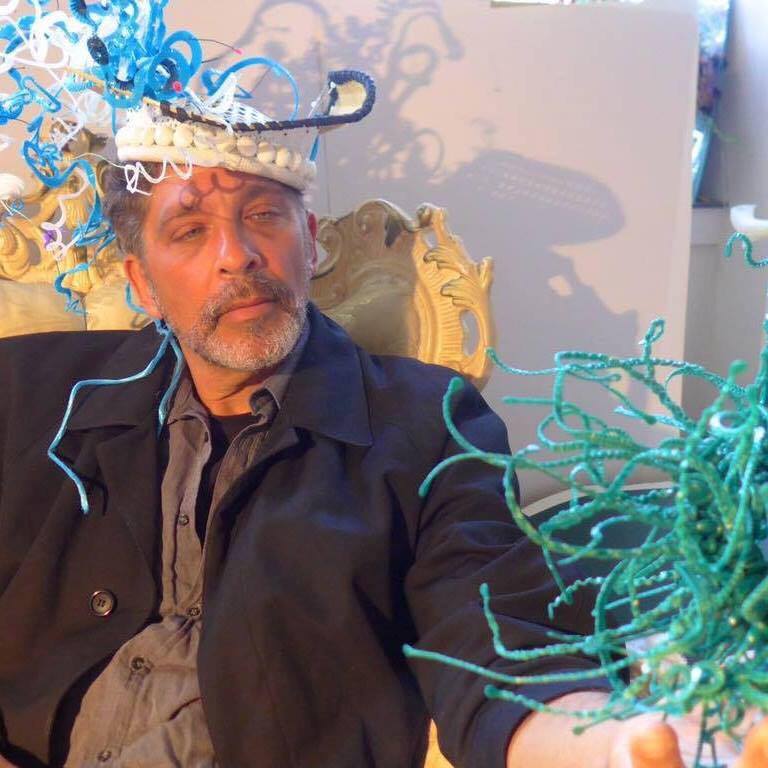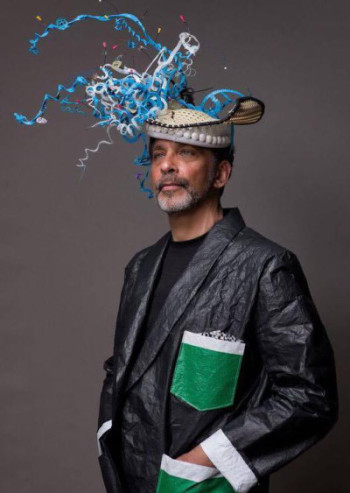
Our Maker VISTA member, Karim Willens, was recently invited to participate in a three-day making seminar at the Dreamyard Institute in the Bronx, NY. There, he heard from and met some amazing makers and was inspired to interview a few of them as part of a “Makers of New York” series. In this post, Karim interviews Daniel Lazilotta, an environmental artist. Using trash that he finds in the ocean, he creates sculptures and other abstract objects to show that the creative potential of trash is limitless. He has had his work displayed at art exhibits and events like Trashion Fashions.
As you read through this interview, consider how you might encourage youth in your learning environment to think about using trash and recycled materials in creative ways. We hope that you are inspired by Daniel and that you are motivated to use making to help your own community.
Please note that this interview has been lightly edited for clarity and length.
How do you think you became a maker?
I started making things very early on as a very little boy. I have been making and building my entire life. We had our own house growing up in the Bronx. My father would always bring all sorts of junk home electronics and I would break them apart. I would go around to open areas where people would just dump stuff and a lot of people would dump bicycles. So my friends and I would take them to my garage and take them apart. So if somebody had a good tire or somebody had a good break or a tube or a pedal or a handlebar. We would compile all these different parts together and then we would wind up getting a bicycle out of it so that was a great pleasure. I just have a lust for making and building stuff.
Growing up, did somebody inspire you as a maker?
My entire family. My grandfather on my mother’s side came from Sicily, at a very early age and he worked with his brothers. They worked with plaster and did very fancy plaster jobs, the very fancy things you would see in office buildings. My father’s father, my grandfather on my father’s side, did the same thing but with marble. I sort of absorbed all of that; I work with all materials in very different stages of execution, so it’s either rough in or very fine work. I go from one extreme to the other doing the rough stuff to the final finishes in many disciplines.
What are some of your earliest and fondest memories of making are?
Oh god, I have a tremendous amount of memories! I can tell you that my making stuff goes back to my early childhood. I did many things with my father, my mother. It was very balanced, I would cook with my mother and various other members of my family. I wound up becoming a chef. With my father, it was always building stuff. I can still feel it in my body: my father showing me how to use a nail set to nail into wood, then put putty over it. Anytime I still do that type of work I can actually feel the energy of my father in my body. One of the greatest things that I have a memory of was a go-cart that me and my father built out of wood. I could actually rebuild that thing to scale exactly the way he and I did it back then. It’s just so clear in my head. The color we painted it, is so clear in my head. I think with the things we face today in terms of the manufacturing situation leaving America. I think it’s a connection that parents have with their children. That’s it’s a parent’s responsibility to show their children to do something for themselves. I’m a very big believer in self-reliance and taking care of one’s self through making stuff. We have tremendous access to tools or technology and unfortunately people don’t seem to be using their hands as much.
What did you guys make?
We made everything together. The funny thing about growing up in New York City in the Bronx when somebody needed something we built it as a group, so there was that traditional feeling of participating in somebody else’s project. There was no money involved you didn’t get paid for that kind of stuff. My grandma was a seamstress so she was sewing everything. My mother was a cook, she was cooking everything; there were a lot of cooks in my family, bakers, lots of people using the sense of one’s touch. In the society that we live in, a lot of people frown upon people who make things with their hands. Working with your hands has never been a number one priority in America it has always been moving up from that and get a job in an office setting. People who work with their hands are happy people they are making, sewing, cooking, cutting and there is no substitute for that. That is self-reliance and self-satisfaction, a great sense of accomplishment. There are so many positive aspects about teaching kids how to use their hands. It takes a lot of concentration, lots of planning, a lot of skill to get it finished. We need people who build things who have visions of how things are made and designed. We need human beings to look at situations and understand what the problems are and then solve those problems through different mechanisms and methods. There has to be this wonderful marriage between the vision, and the pursuit of the vision, then following through.
What’s the idea behind your whole plastic project for you?
Well, it started off innocently, back in the day, when my son was three years old in France. I would collect little pieces of plastic that I would find along the ground on the beach and I would just put them together – but, I couldn’t use any screws. There would have to be a subconscious method, how these things fit together. Then eventually I started changing the rules. I started bringing parts and pieces home and then I started using hot glue and wires there to make sculptures and a week would go by. I started getting a lot of pieces and then I started looking at myself as more of an artist. Then I was just sitting there watching my son play on the beach and then I started noticing this is 20 years of this. My son is 22 years old. I kept finding the same stuff over and over again on the beaches. I started wondering why this is, and I started realizing that the ocean was throwing the stuff back up that we were dumping in the ocean. Little by little I became an environmentalist. I started switching out the plastic for wood. I started using different materials to make different types of sculptures. Then I had a very big tragedy 5 years ago. My girlfriend’s daughter was killed in a trucking accident. She was 12 years old. It was a massive giant thing for me, I wanted to honor her as a young environmentalist, so I became an environmentalist artist. I went back to France a year and a half ago to create a memorial sculpture show for her. I built 26 sculptures out of plastic debris I found in the ocean and various other places, but most of it coming off the beaches.

Who are you trying to inspire with your artwork?
I want to inspire people to think twice about what they are doing. About their environment and their choices. It is their future. As an artist, I’m really interested in creating a problem for myself to see how I can solve the problem. And that is really a skill set that we need to have kids learn so that when a problem does appear they have the ability to look at the situation and find the solution.
Have you tried to integrate the artwork you do into education in any way?
Oh yeah in a big way. For instance, last year, my friend asked me to come to give a class to these kids in the city. I went to Starbucks and got stirring sticks, straws, and plastic cards that you put money on. So I went to the class, I ask the kids what is this, what is the potential of the stick, straw, and the card? I cut it in different angles, and I twisted the plastic card so it, becomes a fan and then I punched a hole in the center of that, stuck it on the stirring stick and then I stuck the stirring stick into the straw. I took all that and made a turbine. All from Starbucks stuff, that was the lesson for them to start looking at objects that would be in their life in an ordinary way and ask students to say to themselves what else could this be. I tried to bring it back to the kids by looking at themselves and thinking about their potential as a person because I want them to look at themselves the same way they would look at the sticks or the straw. You’re just not this kid, you are more than that, you can be anything you want. This is America, and the mythology becomes a reality for them.
What is next for you with your own artwork that you are doing?
We are going to do a documentary and speak to the people about the pieces that come from the ocean. It’s an interview documentary that will be sent out to different tv stations and different galleries. A television show is in the works right now which will be produced on cable television here in Connecticut. The producer is coming on Saturday. The show is being written right now and will go into production in the next coming weeks hopefully from that PBS will look at it and will go into a national place. The people that are backing me, they see me as the Anthony Bourdain of garbage and trash and making stuff. This interview is also important to me as a maker and I hope that this will inspire people to make things and look at things in a different way. I go out into the world every day and I pick up stuff. I have things in my pockets every day, no matter how tiny that little piece of something I find, I think of it in a very big way. It’s about the little things and about the potentials. The little thing I just found could become a potentially big thing. And that is the excitement about being a found-objects artist or environmental artist is to see how big this could be.

Leave a Reply